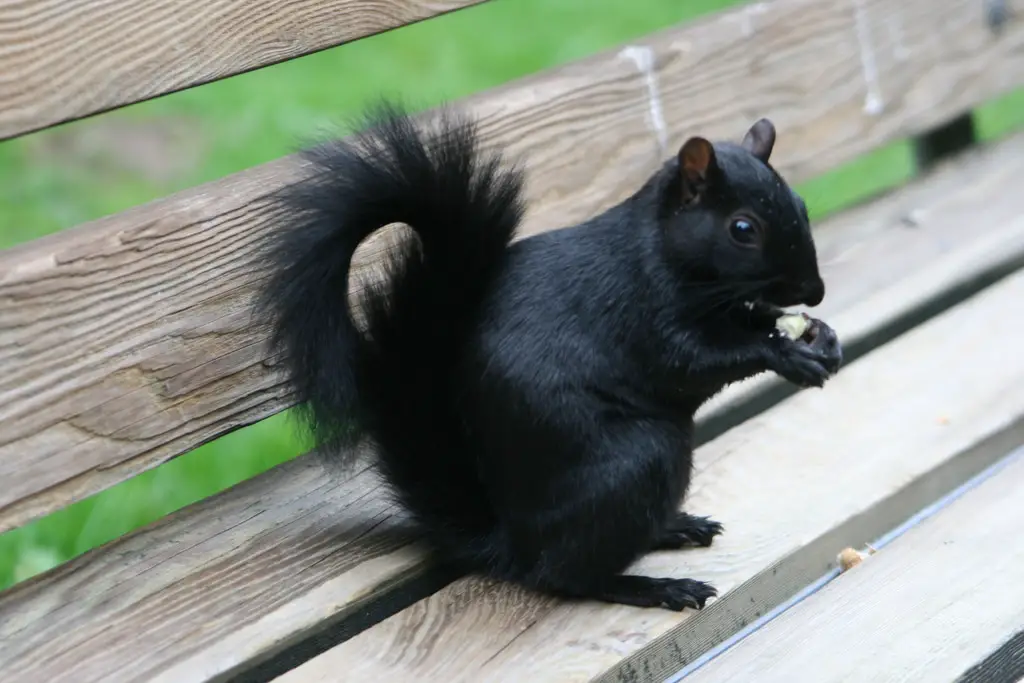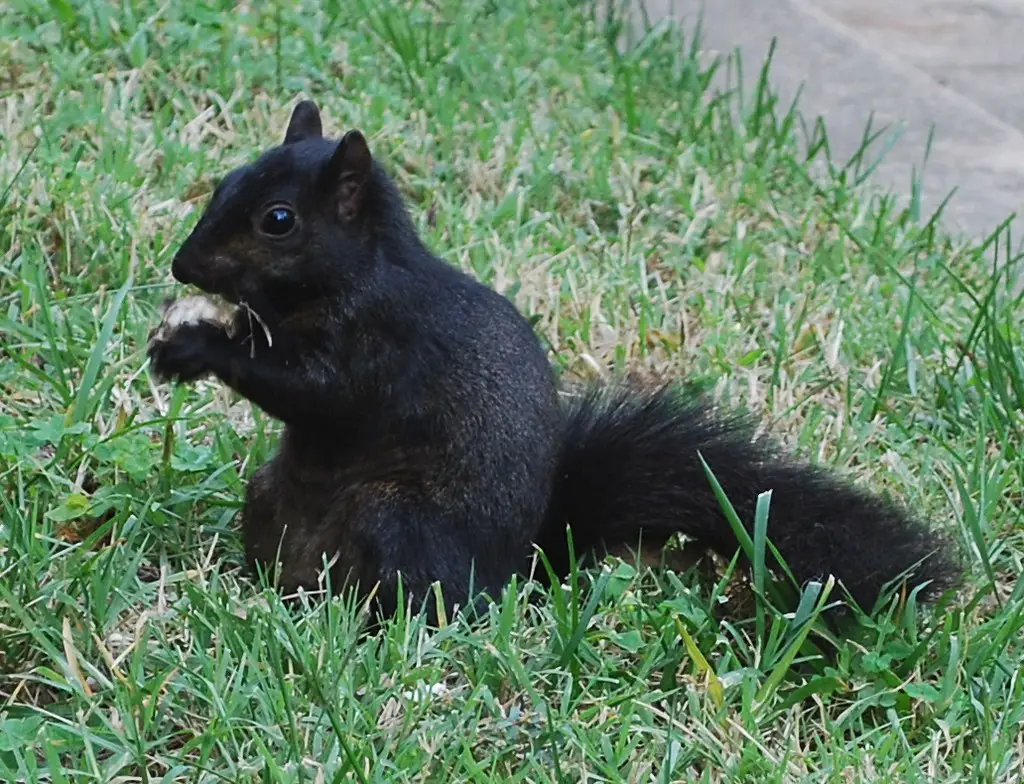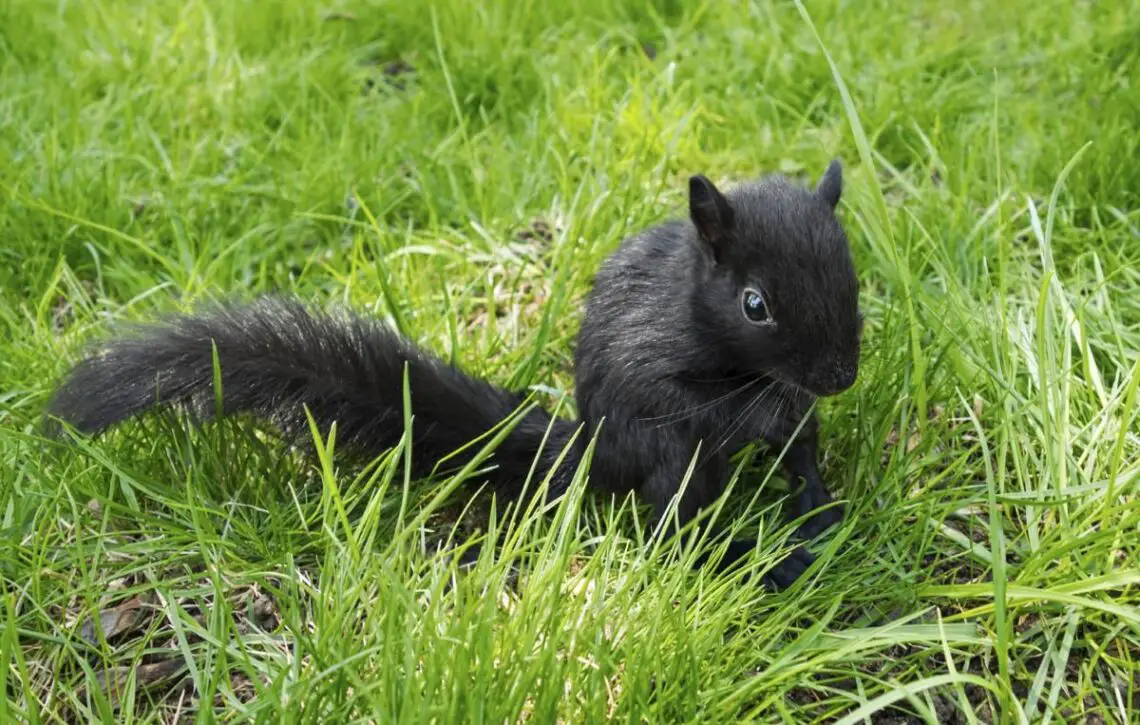Introduction
Are Black Squirrels Rare: Black squirrels have long captured the curiosity and fascination of people across the world. Their striking appearance, characterized by a glossy black fur coat, sets them apart from the more common gray and red squirrel varieties. Black squirrels feeders are not a separate species but rather a color variant of the eastern gray squirrel. They are most commonly found in North America, primarily in regions of the United States and Canada. In recent years, sightings of these ebony-coated rodents have sparked discussions and debates about their rarity, adding an air of mystery to their existence. The rarity of black squirrels, it’s essential to delve into their genetics.
The black coat color is caused by a genetic mutation called melanism, which results in an increased production of melanin, the pigment responsible for dark colors in animals’ fur or skin. This mutation occurs in a small percentage of the gray squirrel population, making black squirrels less common than their gray counterparts. However, the rarity of black squirrels can vary significantly depending on the geographical region. Some areas are known for having a higher concentration of black squirrels, while in others, they are exceptionally scarce.
This distribution has led to varying perceptions of their rarity in different parts of North America. In this exploration of black squirrels, we will delve deeper into their origins, the science behind their black fur, the cultural significance they hold, and the factors that contribute to their prevalence or scarcity in different areas. By the end of this discussion, you’ll have a clearer understanding of the enigmatic world of black squirrels and be better equipped to answer the question of their rarity.

Why are black squirrels rare?
This, some researchers suggest, is due to the old-growth eastern forests and dense canopy. Darker squirrels blended in better. As forests were cut and more open environments prevailed, they argue, lighter-colored squirrels survived better. Now, black squirrels are rare and gray squirrels predominate.
The primary factor contributing to the rarity of black squirrels is genetics. Black squirrels are not a distinct species but rather a color variant of the eastern gray squirrel. Their dark coloration is the result of a genetic mutation known as melanism. Melanism leads to an overproduction of melanin, the pigment responsible for dark colors in animals’ fur or skin. When this mutation occurs, it results in the black coat that characterizes black squirrels.
The distribution of black squirrels is not uniform, further contributing to their rarity. They are most commonly found in North America, particularly in parts of the United States and Canada. In some regions, such as Ohio and certain areas in Canada, black squirrels are relatively common due to higher frequencies of the melanistic mutation. Conversely, in many other areas, black squirrels are infrequent, making sightings of them a special occurrence.
Human activities also play a role in the rarity of black squirrels. Urbanization, deforestation, and habitat loss have had significant impacts on squirrel populations in general. As human developments encroach upon natural habitats, squirrel populations, including black squirrels, face challenges in finding suitable places to live and sources of food.
Are black squirrels aggressive?
Scientists and laypeople alike have observed that black squirrels tend to exhibit more aggressive behaviour than others. This is important because a more aggressive animal may be more likely to move into human habitation, requiring squirrel removal Hamilton.
Before delving into the aggressiveness of black squirrels, it’s that squirrels, in general, are not inherently aggressive animals. They are known for their curious and skittish nature, which is primarily driven by their survival instincts. Squirrels are primarily herbivorous and spend much of their time foraging for nuts, seeds, fruits, and other vegetation. Their seemingly erratic behavior, such as darting around and chattering, is often a response to perceived threats or to establish territory.
Squirrels are territorial creatures, and they may become more assertive when defending their territory, especially during mating season or when resources like food and nesting sites are limited. Female squirrels can exhibit protective behaviors when they have young offspring, as they are highly invested in their survival. Squirrels may become more assertive when competing with other squirrels for food or shelter, which can sometimes be mistaken for aggression.
Squirrels are generally wary of humans and will often flee when approached. However, if they feel cornered or threatened, they may display defensive behaviors, which could include vocalization, lunging, or even biting. To minimize potential conflicts with squirrels, including black squirrels, it’s advisable to maintain a respectful distance and avoid actions that might be perceived as threatening. Feeding squirrels can sometimes lead to undesirable behavior, as it can disrupt their natural foraging patterns and make them more comfortable approaching humans.
Can grey and red squirrels mate?
Greys carry this virus with no threat to themselves but if transmitted into a red population, it can decimate the red squirrel numbers within weeks. For these reasons, co-existing is simply not possible and as they are different species, they will not cross breed.
Size and Appearance: Grey squirrels are generally larger than red squirrels. Grey squirrels have grayish-brown fur with a white underside, while red squirrels are smaller and, as the name suggests, have reddish-brown fur with a white underside. The coloration is one of the most noticeable differences between the two.
Behavior and Diet: Grey squirrels are known to be more adaptable and competitive for resources than red squirrels. They have a broader diet and are better equipped to thrive in a variety of environments.
Geographic Isolation: Grey squirrels and red squirrels have largely non-overlapping native ranges. Red squirrels are found in Europe and parts of Asia, while grey squirrels are native to North America. This geographical separation makes it unlikely for them to encounter each other in the wild.
Behavioral Differences: Even if they were to come into contact, the behavioral differences between the two species, such as mating rituals and preferences, would likely serve as barriers to interbreeding.
What is a golden squirrel?
The golden-mantled ground squirrel (Callospermophilus lateralis) is a ground squirrel native to western North America. It is distributed in the Rocky Mountains of British Columbia and Alberta, and through much of the western United States. Golden-mantled ground squirrel. Conservation status.
Albino or Leucistic Squirrels: One common interpretation of a golden squirrel is an albino or leucistic squirrel with a predominantly white or pale coat and pink eyes. Albinism is a genetic condition that results in the absence of pigmentation, while leucism is a condition where there is partial loss of pigmentation. In either case, the squirrel’s fur may appear golden or pale due to the absence of melanin, the pigment responsible for coloration in mammals.
Seasonal Changes: Some squirrel species, like the Eurasian red squirrel (Sciurus vulgaris), undergo seasonal changes in coat color. During the winter months, their fur can appear more golden or brownish-gray compared to the reddish-brown hue they exhibit in the summer. These seasonal variations in coat color are often referred to as “golden” when the fur takes on a warmer, golden tone.
Variations in Natural Color: Squirrels, in general, come in a variety of natural colors, ranging from gray to black, red to brown. In some regions, you may find squirrels with fur that appears more golden or tawny compared to the standard coloration for their species. These variations in natural color can lead to the description of “golden squirrels.”
What is the smartest squirrel?
Gray squirrels may not look so smart when they’re frantically burying acorns they may never find again, but they appear to be smarter than the red squirrels found across the pond.
Eastern Gray Squirrel: The eastern gray squirrel, commonly found in North America, is often considered one of the smartest squirrel species. They have shown remarkable adaptability to urban environments and are known for their ability to navigate complex obstacle courses, solve puzzles, and find food caches they’ve hidden months earlier. They are quick learners and have demonstrated problem-solving skills in various studies.
Red Squirrel: The red squirrel, native to Eurasia, is another species known for its intelligence. They are highly adaptable and have been observed solving problems related to accessing food sources, including pine cones and other seeds. They also engage in complex cache management, hiding their food in multiple locations to avoid theft by other squirrels.
Fox Squirrel: Fox squirrels, native to North America, are considered intelligent due to their ability to solve problems related to foraging and caching food. They have a good memory for the locations of their caches and are known to use deception, pretending to bury food when observed by potential thieves.
Do black and grey squirrels mate?
The black squirrel is the same species as the grey squirrel and poses no threat to the variety. Black squirrels can mate with greys and if this happens offspring will have a combination of faulty and fully working genes, giving them a brown-black coat.
The variation in coat color among eastern gray squirrels is primarily due to a genetic mutation called melanism. In black squirrels, this mutation leads to an overproduction of melanin, resulting in the black fur color. In contrast, gray squirrels typically have grayish-brown fur. However, both black and gray squirrels share the same genetic makeup and belong to the same species.
When black squirrels and gray squirrels mate, their offspring can have a mix of coat colors. This means that a litter of squirrels born to black and gray parents may include both black and gray individuals. The coat color of the offspring is determined by the inheritance of specific genes from their parents.
The prevalence of black and gray squirrels can vary by region. In some areas, such as certain parts of the United States and Canada, black squirrels are more common, while in other regions, gray squirrels dominate. The frequency of each coat color in a particular area can influence the likelihood of black and gray squirrels mating with each other.
Are black squirrels intelligent?
All rodents are intelligent animals, but the squirrel crowns the list for intelligence. While a rat/mouse can outsmart and sometimes outmaneuver a pursuing human, squirrels’ quickness and intellect give them a lead over other predators and more giant creatures.
Problem-Solving Abilities: Squirrels, including black squirrels, have demonstrated remarkable problem-solving abilities in various studies. They are skilled at finding and retrieving food, even when it’s hidden in complex environments. Squirrels have been observed navigating obstacle courses, solving puzzles, and employing creative strategies to access food caches.
Adaptability: Squirrels, including black squirrels, are highly adaptable to different environments, including urban areas. They can quickly learn to exploit new food sources and adapt their behaviors to changing conditions. This adaptability demonstrates a form of cognitive flexibility.
Cache Management: Squirrels engage in complex cache management. They not only bury food items but also employ deceptive tactics, such as pretending to bury food when observed by potential thieves. This behavior suggests an understanding of the importance of safeguarding their resources.
Are black chipmunks rare?
While the Eastern chipmunk (Tamias striatus) is easily recognizable by the characteristic dark and white stripes that run the length of its body, this all-black animal is a rare exception. Described as a melanistic chipmunk, its colour is a result of an over-development of melanin.
Black chipmunks owe their unusual coloration to a genetic mutation called melanism. Melanism is the opposite of albinism; it results in an increased production of melanin, the pigment responsible for dark colors in fur, skin, and feathers. This genetic mutation causes chipmunks to have an excess of melanin, leading to their black or dark-colored fur.
The presence of black chipmunks can vary by region. Some areas may have a higher frequency of melanistic chipmunks due to a greater prevalence of the melanism gene in the local chipmunk population. However, in many regions, melanistic chipmunks are indeed a rare sight.
Black chipmunks’ unique appearance can be both an advantage and a disadvantage. Their dark coloration may better camouflage in certain environments, such as heavily forested areas with darker leaf litter. However, their striking appearance may also make them more visible to predators, particularly birds of prey.

Conclusion
In black squirrels are rare. It is a fascinating one that leads us on a journey through the realms of genetics, geography, and cultural significance. While it is clear that black squirrels are not a separate species but rather a color variant of the eastern gray squirrel, their rarity is a relative concept, heavily influenced by location and local populations. Genetically, black squirrels owe their striking coloration to a mutation called melanism, which increases the production of melanin, resulting in their ebony fur. This mutation occurs sporadically within the gray squirrel population, making black squirrels less common than their gray counterparts.
However, rarity is not solely defined by squirrels genetic it also takes into account their distribution across different regions. The distribution of black squirrels is far from uniform. Some areas, like certain parts of the United States and Canada, have higher concentrations of black squirrels, making them relatively common sightings. In contrast, in many other regions, these striking creatures are indeed rare and elicit excitement and wonder when spotted. The cultural significance of black squirrels adds another layer to their story.
In some areas where they are more prevalent, such as Ohio and the United Kingdom, black squirrels have become local icons and sources of pride. They even feature in local folklore and legends. Their uniqueness and rarity in certain places contribute to their symbolic value, making them a symbol of local identity and pride. Ultimately, the rarity of black squirrels is a nuanced concept that can vary significantly based on location and perspective. To some, they are everyday inhabitants of their environment, while to others, they are a rare and captivating sight.





No Comments